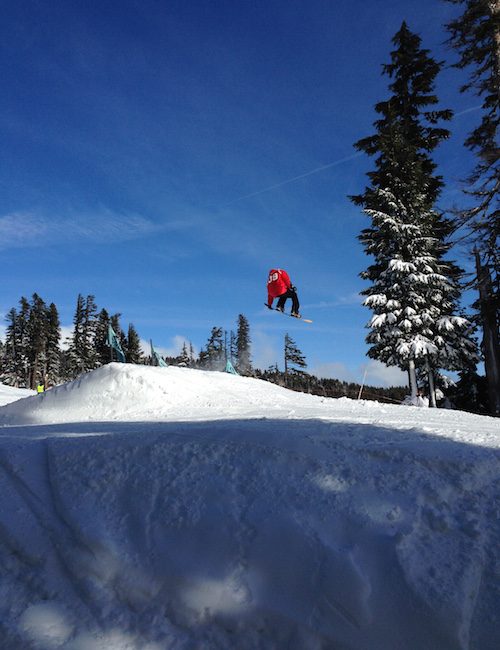Head Judge Frost: “DAVE.”
Me: “DAVE?”
Head judge Frost: “DAVE.”
This was the brief give-and-take that commenced when I asked Head Judge Frost how he would be scoring the riders tricks at the opening to the slopestyle season for riders in the Three Rivers League of the Oregon Interscholastic Snowboard Association (OISA). He then went on to elaborate that DAVE was an acronym that stood for difficulty, amplitude, variation, and execution. This made more sense than just DAVE.
In a competition full of talented students from six different schools, an acronym like this comes in handy when determining riders’ scores.
It was extremely lucky that I was even able to have this conversation with Frost. The drive up to Mt. Hood Meadows featured an ambitious Subaru risking life and limb to catch some freshies at one end of the risk-reward curve and a series of slow moving soccer moms at the other, and a host of skier dads who forgot to chain up in between. And it wasn’t so much “in-between” as “within a half-mile of Meadows,” when stopping to chain up means everyone behind you stops for you to chain up.
The combination of this cast of characters had me standing in line for the bus at the overflow parking lot at 9:45 rather than at the competition I was supposed to be covering that started at 9:30. Then, the universe decided to pay me back for my suffering on the drive up: the guy behind me in line turned out to be Frost, the head judge of the competition. This meant two things: I got a chance for a “pregame interview,” and the competition wasn’t going to be starting without me. In fact, it wasn’t going to be starting for a very long time, because the bus was somewhere behind the soccer moms and the skier dads (but way behind the Subaru driver, who was no doubt catching his freshies). I had a significant amount of time to learn more about Frost and pick his brain about all things DAVE.
Head Judge Frost (not his given name, but the name he chooses to be called) has had a range of experience in the snowboarding world including designing the Timberline Lodge logo in 1996. He has been an OISA judge for five years.
Frost outlined that riders were encouraged to attempt tricks that they have practiced and are confident in rather than attempting new maneuvers during the contest. The judges prefer smooth, in-control riding rather than trying to squeeze in the maximum number of spins before touching back down. A clean three beats a hack job five any day.
Riders were also pushed to display good sportsmanship with fellow riders.
In OISA competitions, all forms of inverted aerials are prohibited except hand plants, in order to safeguard the health of high school students. While I can never get tired of seeing laid-out backies in the park, there are plenty of other ways to score points that don’t require high school students being upside down over packed snow. No doubt they already got their fair share of danger in their Subaru on the way up anyway.
The course was held on the Fireweed park at Mt. Hood Meadows on a course that featured rails, boxes, and jumps. Participants took full advantage of all of the features and weren’t afraid to send combinations of board slides, spins, and sufficiently tweaked grabs.
Participants each got two runs that were scored by three judges. In addition to Frost, the other two judges for this competition were Ethan Field, a former high school competitor, and Donovan Rice, a professional skateboarder.
This was the first slopestyle event of the year for OISA. This association was formed to provide students in Oregon and Washington with a chance to compete on an interscholastic level. Approximately 400 students compete in the OISA slopestyle, banked slalom, halfpipe, boardercross and rail jam competitions.
The thing that stuck out to me the most in my conversation with Frost was the emphasis on sportsmanship. As I watched the competition, I was impressed by the camaraderie I saw. When high schoolers didn’t land their tricks, people were quick to yell encouragements rather than insults. As someone who has had significant experience in not landing tricks, I can sympathize with the riders who just ate snow in front of their friends. A word of encouragement can go a long way towards developing loose, smooth park riding. Of course, I was equally impressed by the 540 sent to the parking lot.
In an ironic sort of way, I ended up being grateful to the people who didn’t chain up as they caused the traffic jam that stuck Frost on the bus with me and let me hear more about the competition from the inside.
Next time, I am going to chain up on the access road so other people can be grateful as well.
For more information on OISA, please visit their website at http://www.oisa.org.
Casey Karlsen is a Mt. Hood enthusiast, former Mt. Hood Meadows snowboard instructor, and snowpark equipment builder. In addition to writing and snowboarding, he enjoys cooking, reading, and fantasy basketball.
Last modified: January 27, 2016


